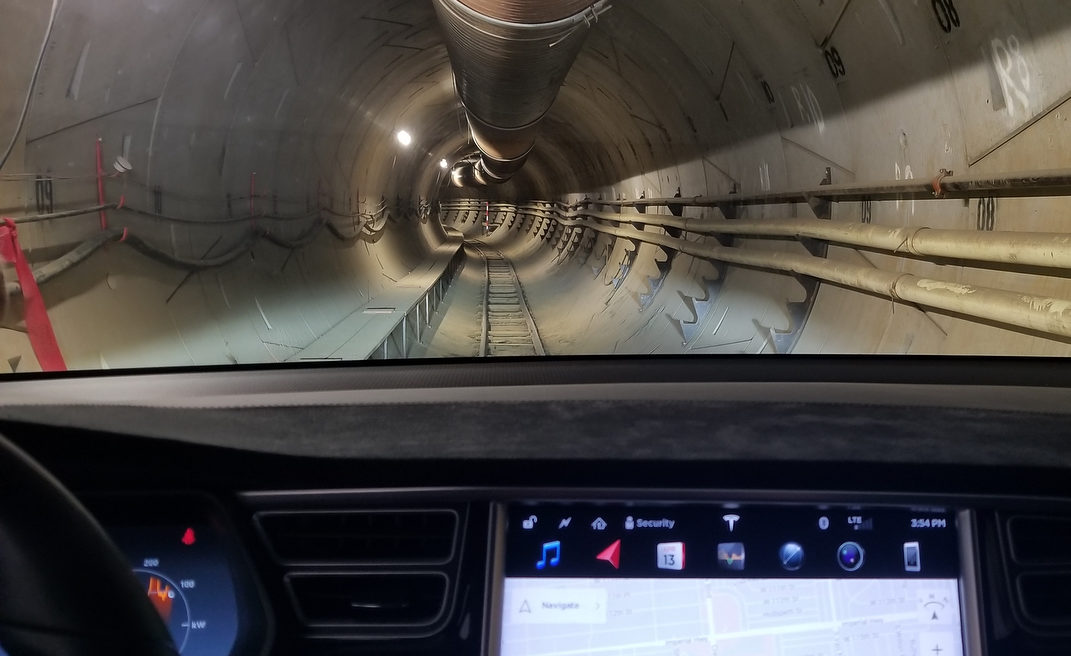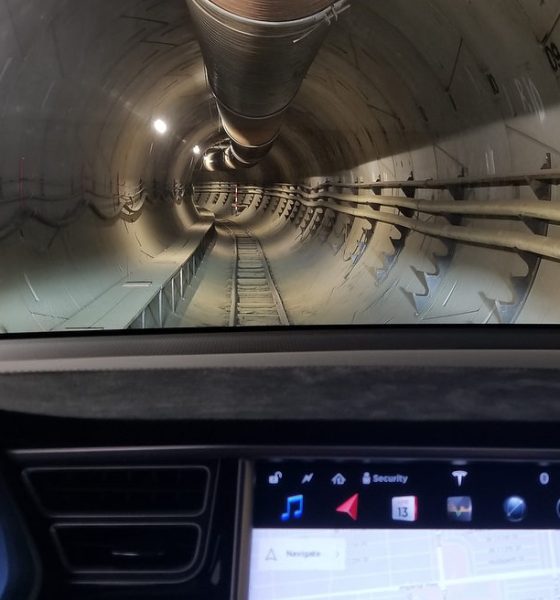

News
Elon Musk’s Boring Co. to build concrete batch plant for tunnel “rings”
Elon Musk’s tunneling startup, The Boring Company, will use custom concrete rings for its tunneling projects. According to a request for tax exclusion that the company submitted to the California Alternative Energy and Advanced Transportation Financing Authority last December, the Boring Co. tunnels will use a type of concrete that is superior to the industry standard.
As stated in the company’s documents, The Boring Company intends to build a batch plant and a carousel system to manufacture and transport concrete rings — tunnel walls made up of multiple segments that are linked together. The tunneling startup expects that the rings it will be producing would be able to withstand earthquakes and over 100 years of continuous use.
The Boring Company noted that it would utilize “advanced materials” to manufacture its tunnels’ concrete walls. The concrete that the company intends to produce would be durable as well, with the startup stating that the segments are expected to reach strengths in excess of 6,500 pounds per square inch.
Apart from this, the startup’s concrete also has a setting time of just 1-7 days, substantially shorter than the industry standard of 28 days. The Boring Company further noted that the concrete it would be using is formulated in a way that would make the segments incredibly dense, making the Boring Co.’s rings less permeable and more resistant to corrosion.
The concrete rings for the Boring Company tunnels are only as effective as the machine that makes and sets them, however. In this light, the tunneling startup stated that it would be using a fully-automated carousel system that is designed to transport and set the concrete rings without human intervention.
“The system used to produce the concrete rings has been customized by The Boring Company, and the company represents that it is the world’s first fully-automated carousel system. This equipment requires precise engineering and will allow for higher precision and speeds than what is currently on the market, according to the TBC.
“Additionally, the fully-automated carousel will enable the production and transportation of the rings without human intervention, but The Boring Company represents that the process will still be monitored by staff for safety and quality from a control center. TBC represents this carousel system, and the specialized moulds will produce rings that are lighter than standard concrete rings, while maintaining their strength.”
The document also revealed that The Boring Co. would be making the manufacturing facility of the concrete rings fully electric. Apart from being more environmentally-friendly than conventional systems that use fossil fuels, an all-electric manufacturing process for the company’s concrete segments is expected to result in a 20% decrease in energy consumption.
The Boring Co. expects to purchase the property for its batch plant within the next 12 months.
While only a year old, the Boring Company has taken some considerable strides this year so far. Just recently, we reported on the startup raising $113 million in a funding round. The startup has also managed to take a step forward in its efforts to build a 2.7-mile proof-of-concept tunnel under Sepulveda Boulevard in West LA and Culver City, with the LA City Council Public Works Committee exempting the company from environmental review under the California Environmental Quality Act (CEQA).

News
Tesla FSD fleet is nearing 7 billion total miles, including 2.5 billion city miles
As can be seen on Tesla’s official FSD webpage, vehicles equipped with the system have now navigated over 6.99 billion miles.

Tesla’s Full Self-Driving (Supervised) fleet is closing in on almost 7 billion total miles driven, as per data posted by the company on its official FSD webpage.
These figures hint at the massive scale of data fueling Tesla’s rapid FSD improvements, which have been quite notable as of late.
FSD mileage milestones
As can be seen on Tesla’s official FSD webpage, vehicles equipped with the system have now navigated over 6.99 billion miles. Tesla owner and avid FSD tester Whole Mars Catalog also shared a screenshot indicating that from the nearly 7 billion miles traveled by the FSD fleet, more than 2.5 billion miles were driven inside cities.
City miles are particularly valuable for complex urban scenarios like unprotected turns, pedestrian interactions, and traffic lights. This is also the difference-maker for FSD, as only complex solutions, such as Waymo’s self-driving taxis, operate similarly on inner-city streets. And even then, incidents such as the San Francisco blackouts have proven challenging for sensor-rich vehicles like Waymos.
Tesla’s data edge
Tesla has a number of advantages in the autonomous vehicle sector, one of which is the size of its fleet and the number of vehicles training FSD on real-world roads. Tesla’s nearly 7 billion FSD miles then allow the company to roll out updates that make its vehicles behave like they are being driven by experienced drivers, even if they are operating on their own.
So notable are Tesla’s improvements to FSD that NVIDIA Director of Robotics Jim Fan, after experiencing FSD v14, noted that the system is the first AI that passes what he described as a “Physical Turing Test.”
“Despite knowing exactly how robot learning works, I still find it magical watching the steering wheel turn by itself. First it feels surreal, next it becomes routine. Then, like the smartphone, taking it away actively hurts. This is how humanity gets rewired and glued to god-like technologies,” Fan wrote in a post on X.
News
Tesla starts showing how FSD will change lives in Europe
Local officials tested the system on narrow country roads and were impressed by FSD’s smooth, human-like driving, with some calling the service a game-changer for everyday life in areas that are far from urban centers.

Tesla has launched Europe’s first public shuttle service using Full Self-Driving (Supervised) in the rural Eifelkreis Bitburg-Prüm region of Germany, demonstrating how the technology can restore independence and mobility for people who struggle with limited transport options.
Local officials tested the system on narrow country roads and were impressed by FSD’s smooth, human-like driving, with some calling the service a game-changer for everyday life in areas that are far from urban centers.
Officials see real impact on rural residents
Arzfeld Mayor Johannes Kuhl and District Administrator Andreas Kruppert personally tested the Tesla shuttle service. This allowed them to see just how well FSD navigated winding lanes and rural roads confidently. Kruppert said, “Autonomous driving sounds like science fiction to many, but we simply see here that it works totally well in rural regions too.” Kuhl, for his part, also noted that FSD “feels like a very experienced driver.”
The pilot complements the area’s “Citizen Bus” program, which provides on-demand rides for elderly residents who can no longer drive themselves. Tesla Europe shared a video of a demonstration of the service, highlighting how FSD gives people their freedom back, even in places where public transport is not as prevalent.
What the Ministry for Economic Affairs and Transport says
Rhineland-Palatinate’s Minister Daniela Schmitt supported the project, praising the collaboration that made this “first of its kind in Europe” possible. As per the ministry, the rural rollout for the service shows FSD’s potential beyond major cities, and it delivers tangible benefits like grocery runs, doctor visits, and social connections for isolated residents.
“Reliable and flexible mobility is especially vital in rural areas. With the launch of a shuttle service using self-driving vehicles (FSD supervised) by Tesla in the Eifelkreis Bitburg-Prüm, an innovative pilot project is now getting underway that complements local community bus services. It is the first project of its kind in Europe.
“The result is a real gain for rural mobility: greater accessibility, more flexibility and tangible benefits for everyday life. A strong signal for innovation, cooperation and future-oriented mobility beyond urban centers,” the ministry wrote in a LinkedIn post.
News
Tesla China quietly posts Robotaxi-related job listing
Tesla China is currently seeking a Low Voltage Electrical Engineer to work on circuit board design for the company’s autonomous vehicles.

Tesla has posted a new job listing in Shanghai explicitly tied to its Robotaxi program, fueling speculation that the company is preparing to launch its dedicated autonomous ride-hailing service in China.
As noted in the listing, Tesla China is currently seeking a Low Voltage Electrical Engineer to work on circuit board design for the company’s autonomous vehicles.
Robotaxi-specific role
The listing, which was shared on social media platform X by industry watcher @tslaming, suggested that Tesla China is looking to fill the role urgently. The job listing itself specifically mentions that the person hired for the role will be working on the Low Voltage Hardware team, which would design the circuit boards that would serve as the nervous system of the Robotaxi.
Key tasks for the role, as indicated in the job listing, include collaboration with PCB layout, firmware, mechanical, program management, and validation teams, among other responsibilities. The role is based in Shanghai.
China Robotaxi launch
China represents a massive potential market for robotaxis, with its dense urban centers and supportive policies in select cities. Tesla has limited permission to roll out FSD in the country, though despite this, its vehicles have been hailed as among the best in the market when it comes to autonomous features. So far, at least, it appears that China supports Tesla’s FSD and Robotaxi rollout.
This was hinted at in November, when Tesla brought the Cybercab to the 8th China International Import Expo (CIIE) in Shanghai, marking the first time that the autonomous two-seater was brought to the Asia-Pacific region. The vehicle, despite not having a release date in China, received a significant amount of interest among the event’s attendees.








